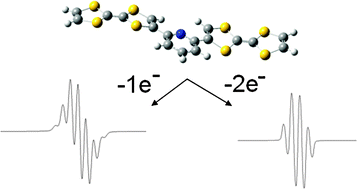Bis(tetrathiafulvalenes) with aromatic bridges: electron delocalization in the oxidized species through EPR and theoretical studies†
Abstract
A series of

* Corresponding authors
a
Université d'Angers, CNRS, Laboratoire de Chimie et Ingénierie Moléculaire, CIMA UMR 6200, UFR Sciences, Bât. K, 2 Bd., Lavoisier, 49045 Angers, France
E-mail:
narcis.avarvari@univ-angers.fr
Fax: (+33)02 41 73 54 05
b
Department of Physical Chemistry, University of Geneva, 30 Quai Ernest Ansermet, 1211 Geneva, Switzerland
E-mail:
Michel.Geoffroy@unige.ch
Fax: (+41)22-379-6103
A series of

 Please wait while we load your content...
Something went wrong. Try again?
Please wait while we load your content...
Something went wrong. Try again?
F. Riobé, N. Avarvari, P. Grosshans, H. Sidorenkova, T. Berclaz and M. Geoffroy, Phys. Chem. Chem. Phys., 2010, 12, 9650 DOI: 10.1039/C001014F
To request permission to reproduce material from this article, please go to the Copyright Clearance Center request page.
If you are an author contributing to an RSC publication, you do not need to request permission provided correct acknowledgement is given.
If you are the author of this article, you do not need to request permission to reproduce figures and diagrams provided correct acknowledgement is given. If you want to reproduce the whole article in a third-party publication (excluding your thesis/dissertation for which permission is not required) please go to the Copyright Clearance Center request page.
Read more about how to correctly acknowledge RSC content.
 Fetching data from CrossRef.
Fetching data from CrossRef.
This may take some time to load.
Loading related content
